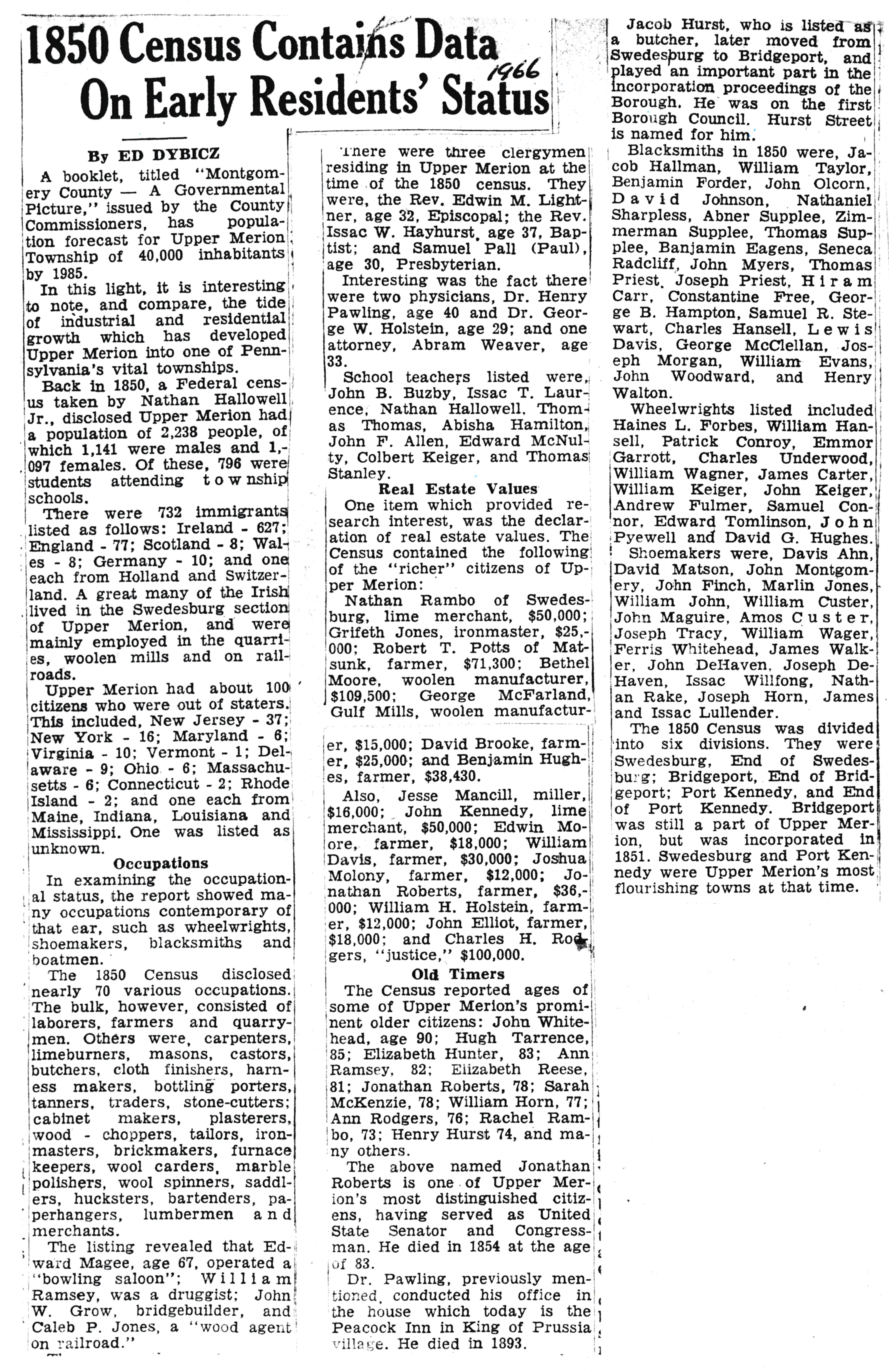With the 2020 census coming up, here is an Ed Dybicz article on the 1850 census.
1850 Census Contains Data On Early Resident’s Status
by Ed Dybicz 1966
A booklet, titled “Montgomery County – A Governmental Picture,” issued by the County Commissioners, has population forecast for Upper Merion Township of 40,000 inhabitants by 1985.
In this light, it is interesting to note, and compare, the tide of industrial and residential growth which has developed Upper Merion into one of Pennsylvania’s vital townships.
Back in 1850, a Federal census taken by Nathan Hallowell Jr., disclosed Upper Merion had a population of 2,238 people, of which 1,141 were males and 1,097 females. Of these, 796 were students attending township schools.
There were 722 immigrants listed as follows: Ireland – 627; England – 77; Scotland -8; Wales – 8; Germany – 10; and one each from Holland and Switzerland. A great many of the Irish lived in the Swedesburg section of Upper Merion, and were mainly employed in the quarries, woolen mills and on railroads.
Upper Merion had about 100 citizens who were out of staters. This included, New Jersey – 37; New York – 16; Maryland – 6; Virginia 1-: Vermont – 1: Delaware – 9; Ohio – 6; Massachusetts – 6; Connecticut -2; Rhode Island – 2; and one each from Maine, Indiana, Louisiana and Mississippi. One was listed as unknown.
Occupations
In examining the occupational status, the report showed many occupations contemporary of that era, such as wheelwrights, shoemakers, blacksmiths and boatmen.The 1850 Census disclosed nearly 70 various occupations. The bulk, however, consisted of laborers, farmers and quarrymen. Others were, carpenters, limeburners, masons, castors, butchers, cloth finishers, harness makers, bottling porters, tanners, traders, stone-cutters; cabinet makers, plasterers, wood – choppers, tailors, ironmasters, brickmakers, furnace keepers, wool carders, marble polishers, wool spinners, saddlers, hucksters, bartenders, paperhangers, lumbermen and merchants.
The listing revealed that Edward Magee, age 67, operated a “bowling saloon”; William Ramsey, was a druggist; John W. Grow, bridgebuilder, and Caleb Pl Jones, a “wood agent on railroad.”
There were three clergymen residing in Upper Merion at the time of the 1850 census. They were, the Rev. Edwin M. Lightner, age 32, Episcopal; the Rev. Issac W. Hayhurts, age 37, Baptist; and Samuel Pall (Paul) age 30, Presbyterian.
Interesting was the fact there were two physicians, Dr. Henry Pawling, age 40 and Dr. George W. Holstein, age 29; and an attorney, Abram Weaver, age 33.
School teachers listed were John B. Buzby, Issac T. Laurence, Nathan Hallowell, Thomas Thomas, Abisha Hamilton, John F. Allen, and Edward McNulty, Colbert Keiger, and Thomas Stanley.
Real Estate Values
One item which provided research interest, was the declaration of real estate values. The Census contained the following of the “richer” citizens of Upper Merion:Nathan Rambo of Swedesburg, lime merchant, $50,000; Grifeth Jones, ironmaster, $25,000; Robert T. Potts of Matsunk, farmer, $71,300; Bethel Moore, woolen manufacturer, $109,500; George McFarland, Gulf Mills, woolen manufacturer, $15,000; David Brooke, farmer, $25,000; and Benjamin Hughes, farmer, $38,430.
Also, Jesse Mancill, miller, $16,000; John Kennedy, lime merchant, $50,000; Edwin Moore, farmer, $18,000; William Davis, farmer, $30,000; Joshua Molony, farmer, $12,000; Jonathan Roberts, farmer, $36,000; William Holstein, farmer, $12,000; John Elliot, farmer, $18,000; and Charles H. Rodgers, “justice,” $100,000.
Old Timers
The Census reported ages of some of Upper Merion’s prominent older citizens; John Whitehead, age 90; Hugh Tarrence, 85; Elizabeth Hunter, 85; Ann Ramsey, 82; Elizabeth Reese, 81; Jonathan Roberts, 78; Sarah McKenzie, 78; William Horn, 77; Ann Rodgers, 76; Rachel Rambo, 73; Henry Hurst, 74, and many others.The above named Jonathan Roberts is one of Upper Merion’s most distinguished citizens, having served as United State Senator and Congressman. He died in 1854 at the age of 83.
Dr. Pauling, previously mentioned, conducted his office in the house which today is the Peacock Inn in King of Prussia village. He died in 1893.
Jacob Hurst, who is listed as a butcher, later moved from Swedesburg to Bridgeport, and played an important part in the incorporation proceedings of the Borough. He was on the first Borough Council. Hurst Street is named for him.
Blacksmiths in 1850 were, Jacob Hallman, William Taylor, Benjamin Forder, John Olcorn, David Johnson, Nathaniel Sharpless, Abner Supplee, Zimmerman Supplee, Thomas Supplee, Benjamin Eagens, Seneca Radcliff, John Myers, Thomas Priest, Jose Priest, Hiram Carr, Constatine Free, George B. Hampton, Samuel R. Steward, Charles Hansell, Lewis David, George McClellan, Joseph Morgan, William Evans, John Woodward, and Henry Walton.
Wheelwrights listed included Haines L. Forbes, William Hansell, Patrick Conroy, Emmer Garrott, Charles Underwood, William Wagner, James Carter, William Keiger, John Keiger, Andrew Fulmer, Samuel Connor, Edward Tomlinson, John Pyewell and David G. Hughes.
Shoemakers were, Davis Ahn, David Matson, John Montgomery, John Finch, Marlin Jones, William John, William Custer, John Maguire, Amos Custer, Joseph Tracy, William Wager, Ferris Whitehead, James Walker, John DeHaven, Joseph DeHaven, Issac Willfong, Nathan Rake, Joseph Horn, James and Issac Lullender.
The 1850 Census was divided into six divisions. They were Swedesburg, End of Swedsburg; Bridgeport, End of Bridgeport; Port Kennedy, and End of Port Kennedy. Bridgeport was still a part of Upper Merion, but was incorporated in 1851. Swedesburg and Port Kennedy were Upper Merion’s most flourishing towns at that time.

